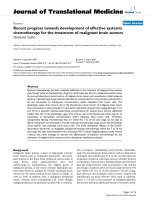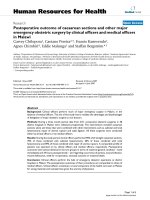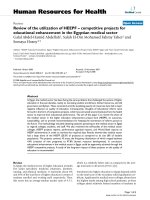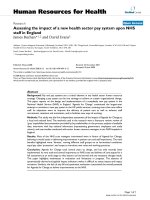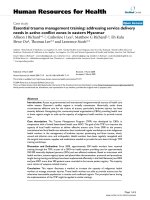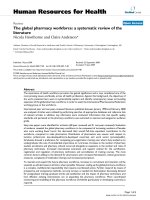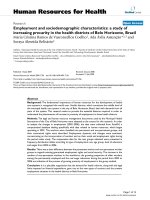báo cáo sinh học:" How labour intensive is a doctor-based delivery model for antiretroviral treatment (ART)? Evidence from an observational study in Siem Reap, Cambodia" potx
Bạn đang xem bản rút gọn của tài liệu. Xem và tải ngay bản đầy đủ của tài liệu tại đây (269.77 KB, 9 trang )
BioMed Central
Page 1 of 9
(page number not for citation purposes)
Human Resources for Health
Open Access
Research
How labour intensive is a doctor-based delivery model for
antiretroviral treatment (ART)? Evidence from an observational
study in Siem Reap, Cambodia
Wim Van Damme*
1
, Soy Ty Kheang
2
, Bart Janssens
2
and Katharina Kober
1
Address:
1
Department of Public Health, Institute of Tropical Medicine, Antwerp, Belgium and
2
Médecins Sans Frontières – Belgium, Phnom Penh,
Cambodia
Email: Wim Van Damme* - ; Soy Ty Kheang - ; Bart Janssens - ;
Katharina Kober -
* Corresponding author
Abstract
Background: Funding for scaling-up antiretroviral treatment (ART) in low-income countries has
increased substantially, but the lack of human resources for health (HRH) is increasingly being
identified as an important constraint for scaling-up ART.
Methods: In a clinic run by Médecins Sans Frontières in Siem Reap, Cambodia, we documented
the use of doctor-time for ART in September 2004 and in August 2005, for different phases in ART
(pre-ART, ART initiation, ART follow-up Year 1, & ART follow-up Year 2). Based on these
observations and using a variety of assumptions for survival of patients on ART (between 90 and
95% annually) and for further reductions in doctor-time per patient (between 0 and 10% annually),
we estimated the need for doctors for the period 2004 till 2013 in the Siem Reap clinic, and in a
hypothetical district in sub-Saharan Africa.
Results: In the Siem Reap clinic, we found that from 2004 to 2005 the doctor-time needed per
patient was reduced by between 14% and 33%, thanks to a reduction in number of visits per patient
and shorter consultation times. In 2004, 2.06 full-time equivalent (FTE) doctors were needed for
522 patients on ART, and in 2005 this was slightly reduced to 1.97 FTE doctors for 911 patients
on ART. By 2013, Siem Reap clinic will need between 2 and 5 FTE doctors for ART. In a district in
sub-Saharan Africa with 200,000 inhabitants and 20% adult HIV prevalence, using a similar doctor-
based ART delivery model, between 4 and 11 FTE doctors would be needed to cover 50% of ART
needs.
Conclusion: ART is labour intensive. Important reductions in doctor-time per patient can be
realized during scaling-up. The doctor-based ART delivery model analysed seems adequate for
Cambodia. However, for many districts in sub-Saharan Africa a doctor-based ART delivery model
may be incompatible with their HRH constraints.
Published: 1 May 2007
Human Resources for Health 2007, 5:12 doi:10.1186/1478-4491-5-12
Received: 8 July 2006
Accepted: 1 May 2007
This article is available from: />© 2007 Van Damme et al; licensee BioMed Central Ltd.
This is an Open Access article distributed under the terms of the Creative Commons Attribution License ( />),
which permits unrestricted use, distribution, and reproduction in any medium, provided the original work is properly cited.
Human Resources for Health 2007, 5:12 />Page 2 of 9
(page number not for citation purposes)
Background
Globally there are some 42 million people living with
HIV/AIDS (PLWHAs), most of them in low-income coun-
tries. Cambodia is the country with the highest HIV prev-
alence in Asia. In 2003, adult HIV prevalence in
Cambodia was assessed as 1.9%, with an estimated 123
000 PLWHAs. This is a significant decrease from 1997,
when HIV prevalence was 3.0%.
Over recent years the prices of antiretrovirals (ARV) have
dropped dramatically and pilot projects have proved that
treating AIDS in the poorest regions of the world is feasi-
ble, with clinical outcomes, such as adherence, evolution
of CD4 counts (which indicate the strength of an immune
system and how far the disease has advanced) and mortal-
ity, being similar to those obtained in resource-rich set-
tings [1,2]. International attention has focussed
increasingly on the expansion of access to anti-retroviral
treatment (ART) for PLWHAs. WHO's '3 by 5' initiative
described the expansion of ART to millions of people as a
"global health emergency", and the G8 declared now to
aim at "Universal Access to ART" by 2010 [3]. Thanks to
major new international initiatives, such as the Global
Fund, the World Bank's Multi-country AIDS Programme
(MAP) and the US. President's Emergency Plan for AIDS
Relief (PEPFAR), total funding for ART has increased sub-
stantially. Most countries with a high HIV/AIDS burden
do no longer lack the funds for initiating and expanding
ART programmes. However, it is becoming clear that pres-
ently the main bottleneck for scaling-up ART is the
absorptive capacity of health systems. In particular, the
lack of human resources for health (HRH) is increasingly
being identified as the main constraint [4]. Only a few
reports have analysed how labour intensive ART for AIDS
patients is [5]. Furthermore, such reports were based
entirely on one-time observations in clinics delivering
ART, usually when such clinics were in their early stages,
with staff still being relatively inexperienced. It is on this
basis that extrapolations have been made of the human
resources needs for ART scale-up [6,7].
In this study we focus on the use of medical doctor time
for ART delivery in a chronic diseases clinic in Siem Reap,
Cambodia, and how this evolved over one year. We then
extrapolate the findings over the 10-year period 2004–
2013, for the Siem Reap clinic, and for a district-wide
expansion of ART to a hypothetical district in sub-Saharan
Africa.
Methods
Setting: the chronic diseases clinic in Siem Reap
The clinic was set up in March 2002 by the humanitarian
medical organization Médecins Sans Frontières as an
ambulatory care centre for adult patients with chronic
conditions in the compound of the provincial hospital of
Siem Reap. The principal chronic diseases treated at the
clinic are, in descending order of importance: HIV/AIDS,
diabetes and hypertension. In October 2002, the first
patients were started on ART. Voluntary counselling and
testing (VCT) is provided in a health centre of the Ministry
of Health (MoH). The clinic has relations with a network
of NGOs and peer support groups for PLWHAs who
organise social services and home-based care. Technical
support services such as laboratory, X-rays and ultrasound
are provided by the provincial hospital. Samples for CD4
counts are sent to the Pasteur Institute in Phnom Penh. An
NGO-run hospital in Siem Reap town treats children with
AIDS.
The clinic prescribes ART for all HIV-positive patients with
a CD4 count below 200. Its ART protocol uses as the
standard first line treatment a fixed-dose combination
consisting of lamivudine (3TC), stavudine (d4T) and nev-
irapine. Zidovudine and efavirenz are alternative first-line
when the patient develops side-effects, drug interaction or
toxicities. The clinic uses tenofovir, lamivudine (3TC) and
lopinavir-boosted ritonavir (Kaletra
®
) for those who are
failing to respond to the first line regimen. Before ART ini-
tiation, haemoglobin and the liver enzyme ALT are meas-
ured at week 2 and month 1. CD4 is measured every 6
months for all HIV-positive patients.
In Cambodia, the overall lack of medical personnel is not
a constraining factor for ART; although misdistribution of
staff may create local shortages. Doctors are trained for 6
six years at the University of Phnom Penh, using a curric-
ulum largely inspired by French medical schools.
Use of doctor-time for ART in Siem Reap clinic, 2004 and
2005
In September 2004 and again in August 2005, we assessed
the use of doctor-time for HIV positive patients on ART.
Our main focus was on the length and frequency of med-
ical doctor consultations for HIV positive patients, from
their first day consultation at the clinic to their latest ART
follow-up visit. Data on the length of patient-doctor
encounters was obtained by direct observation of 12 con-
sultations during one day, followed by discussions with
the doctors. Data on the frequency of doctor-patient
encounters was obtained from the clinic's database. In
September 2004, the clinic had few patients in follow-up
for more than one year. Our second visit at the end of
August 2005 allowed us to observe changes in the fre-
quency and length of doctor-patient encounters as well as
document and compare the time doctors were spending
on the follow-up of patients in year one and year two and
beyond.
We structured our analysis by grouping HIV positive
patients in subsequent phases which we labelled 'preART',
Human Resources for Health 2007, 5:12 />Page 3 of 9
(page number not for citation purposes)
'non-ART', 'ART initiation', 'ART follow-up year 1', and
'ART follow-up year 2' (Figure 1).
The 'pre-ART' phase includes the registration of new
patients, CD4 count and management of the patient.
When a CD4 count reaches less than 200/μl, baseline lab-
oratory parameters are taken, and the patient is further
assessed till the decision is taken to start ART.
When a CD4 count is above 200, patients are seen period-
ically as 'non-ART', including 6-monthly CD4 measure-
ments, until CD4 drops below 200. Following this, the
patients go through 'ART initiation'.
The 'ART-initiation' phase includes three sessions of ART
counselling and an assessment of the ART regimen best
suited for the patient.
'ART follow-up year 1', includes the periodic, often
monthly, consultations for patients on ART during the
first year.
'ART follow-up year 2' covers the periodic visits to the
clinic in the second year. This phase can be further
extended into year 3, year 4 and, if required, into subse-
quent years.
From the data on length and frequency of doctor-patient
encounters in September 2004 and in August 2005, we
estimated the reduction in use of doctor-time over the
course of one year.
Use of doctor time in Siem Reap clinic, simulation 2004 –
2013
Starting from the observations made, we then used a sim-
ple extrapolation to project the expected doctor-time
needed for medical consultations over the ten years
between 1 January 2004 and 31 December 2013. We
assumed that the Siem Reap clinic would have started on
1 January 2004, and have put 40 new patients per month
on ART – as they did in 2004 and 2005 – and this until the
end of 2013. For 2004 and 2005, we used the doctor time
per patient, as observed. For 2006 through to 2013, we
made a combination of assumptions regarding survival of
patients, and possible further reduction in doctor time per
patient.
For survival of patients and reduction of doctor-time per
patient, we did a simulation exercise based on extrapola-
tions with two variables:
1. survival of patients on ART, all stages of the disease
included, is
a. either 90% survival per year, or
b. 95% survival per year; and
2. doctor-time per patient on ART,
a. remains the same after 2005, with no further reduction:
'0% doctor-time reduction'; or
b. there is a continued annual 5% reduction of doctor-
time per patient every year: '5% doctor-time reduction'; or
c. there is a continued annual 10% reduction per year,
every year: '10% doctor-time reduction'.
We assume that all deaths occur on the last day of every
year, either 10% or 5% of PLWHAs on ART. This is a sim-
plification that will tend to overestimate the time needed
Phases in ARTFigure 1
Phases in ART.
Human Resources for Health 2007, 5:12 />Page 4 of 9
(page number not for citation purposes)
for patients who die early in the year, but compensates
somehow for the often intensive follow-up of patients
over the weeks and months before their death.
We assumed that doctor-time needed for HIV positive
patients not yet needing ART will remain constant over
the years, and that during the first year of the simulation
all patients needed a full year-equivalent of follow-up
time, even those who started later in the year, and were
thus followed up on for less than a full year. This assump-
tion may somehow overestimate the need for doctor-time
in the first year, but it is consistent with the observation
that in the beginning, due to inexperience, doctors often
conduct very long consultations with patients on ART. We
estimated that a doctor sees patients for an average of 125
hours per month, or 1500 hours per year, and conse-
quently used these estimates to calculate monthly or
yearly full-time equivalents (FTE).
Extrapolations district-wide, 2004–2013
With similar assumptions, we estimated with simple
extrapolations the need for doctors to treat adults with
ART in a hypothetical district that resembles districts in
high burden countries of central and Southern Africa,
with 200,000 inhabitants, 50% of whom are adults (= 100
000 adults), with a HIV prevalence of 20% (= 20 000 HIV
positive adults). We estimated the annual need for new
ART to be 10% of all HIV positive adults (= 2000 per
year), and that the health services would manage to put
50% of those in need on ART (= 1000 new ART per year).
We used a simulation exercise, similar to the one for the
Siem Reap clinic, with the same variables.
Results
Siem Reap Clinic, 2004 and 2005
Patients
In September 2004, the Siem Reap chronic diseases clinic
was actively following up on 1158 HIV positive people,
636 of which were not yet on ART and 522 of which were
on ART. Among the 460 patients started on ART in 2004,
the median CD4 count at initial assessment was 50 cells/
μl (IQR: 20–117 cells/μl). The clinic was further following
up on some 1000 patients with diabetes, hypertension
and other chronic diseases. By August 2005, the clinic was
following up on 1423 HIV positive people – 512 not yet
on ART and 911 on ART – along with some 1700 patients
with other chronic diseases. Among the 475 patients
started on ART in 2005, median CD4 count at initial
assessment was 75 cells/μl (IQR: 25–161 cells/μl).
Staff
In September 2004 the clinic had four full-time medical
doctors doing the consultations for all chronic patients.
There were two nurses, three counsellors, one pharmacist,
one database operator and six PLWHAs – two involved in
counselling, two in keeping files and guiding patients to
the doctors, and two in organizing home visits of irregular
and defaulter patients. In August 2005, the number of
medical doctors was reduced to three full-time and one
part-time. Other staff remained unchanged. The care
delivered in the clinic can be described as doctor-based:
every patient is seen by a doctor during every visit, and the
doctor takes all decisions on diagnostic procedures and
on treatment. The other staff members execute these deci-
sions.
Consultations
The pre-ART phase for those patients with a CD4 count
below 200 lasted on average 75 days, a time which did not
vary much with the results of the CD4 counts. The clinic's
database showed that during this preparation period the
patients had on average 6 medical appointments until
September 2004, and that this was reduced to 4 by August
2005. The time spent at each consultation remained con-
stant at 15 minutes on average, and ranged between 8 and
23 minutes, depending on the patients' condition. In par-
ticular, patients with active opportunistic infections were
often difficult to diagnose correctly with the limited tech-
nical means available and sometimes needed much more
doctor-time before ART could be initiated.
A considerable number of total consultations are for peo-
ple with a CD4 count above 200 (non-ART phase). These
consultations lasted on average 15 minutes. As the total
time patients stay in this phase is very variable, and can
last several years, an estimation of the number of visits
was impossible.
During ART initiation, the clinic doctors see the patient
three times to prepare the patient for the initiation of ART.
In 2004, these consultations lasted 30 minutes each. In
2005, the doctors had reduced the consultation time con-
siderably to some 20 minutes per visit. We could indeed
observe that non-medical counselling had been com-
pletely delegated to counsellors.
In September 2004 the clinic's database showed that dur-
ing the first year of ART follow-up a patient had on aver-
age 14 consultations. Each visit lasted on average 12
minutes (ranging between 8 and 17 minutes). The length
of the individual consultations did not change in August
2005, but the number of follow-up visits had reduced
from 14 to 12.
In September 2004, there were only 139 patients in the
second year of ART follow-up, most in the first six
months. We counted seven consultations during these six
months of the second follow-up year in the clinic's data-
base. This suggested that the annual consultation rate of
14 visits would not change significantly after the first year
Human Resources for Health 2007, 5:12 />Page 5 of 9
(page number not for citation purposes)
of follow-up. Lacking a confirmed number, we assumed
monthly (i.e. 12 annual) consultations as from the second
year. No observation was made for the second year fol-
low-up consultations, but the clinic doctors reckoned
these to be slightly shorter than during the first year. For
our calculations, we assumed an average length of 10 min-
utes per consultation. In August 2005 it was possible to
calculate more accurately the actual frequency and length
of consultations in the second year of follow-up. The aver-
age number was 10 consultations per patient. The average
length of the individual consultation remained 10 min-
utes. These data are summarized in Table 1, and total doc-
tor-time per patient is calculated.
The total time needed for one PLWHA who went through
the pre-ART phase, then the ART initiation, and who was
followed up during year 1, was 348 minutes with the data
observed in 2004, and 264 minutes with the 2005 data.
Of this total reduction of 84 minutes, 54 minutes is due to
a decrease in number of visits and 30 minutes due to a
reduction in length of consultation. The result is a 24%
reduction in doctor-time per patient in 2005, as compared
to 2004.
In September 2004, the total number of consultations was
1433 for 1158 PLWHAs; 636 without ART and 522 on
ART. In August 2005, there were 1492 consultations for
1423 PLWHAs; 512 without ART and 911 on ART. Table
2 presents how these consultations were divided between
the different ART phases and how much doctor-time was
needed for each phase.
We thus estimated that in 2005 the doctors in the Siem
Reap clinic spent 26 hours less on 1423 HIV positive
patients than they spent in 2004 for 1158 patients (-7%).
The most important gains are obtained in pre-ART and
ART initiation, with 36% of reduction in time needed for
these phases. This reveals a considerable gain in efficiency
of use of doctors' time. There is a big increase (34 hours,
or 126%) in the time spent on ART follow-up for the sec-
ond and sub-sequent years, but this is more than compen-
sated by time gains in earlier phases of ART.
Siem Reap clinic simulation, 2004–2013
Under the assumptions used, the total number of patients
on ART grows to 480 at the end of 2004, to over 912 at the
end of 2005, and to 3126 and 3852 at the end of 2013, for
90% and 95% annual survival respectively. The results for
total doctor-time needed are shown in Figure 2. From
1.86 FTE doctor in 2004 and 1.89 FTE in 2005, the
number of doctors required increases to more than 5 FTE
for the scenario "95% survival – 0% doctor-time reduc-
tion", or to 4.35 FTE for the scenario "90% survival – 0%
doctor-time reduction". Yet, it increases more moderately
to around 3 FTE for the two scenarios with 5% annual
doctor-time reduction, and increases only very slightly for
the two scenarios with 10% annual doctor-time reduc-
tion.
Extrapolation district-wide, 2004–2013
In line with assumptions for the sub-Saharan district
(population 200,000; 20% adult HIV prevalence; 2000
patients yearly in need of ART; 50% coverage of ART
needs), the number of patients on ART will gradually
increase to 6 513 if survival is 90% per year, or to 8 026 if
survival is 95% per year. The results for doctor time are
presented in Figure 3. In all simulations, the initial need
in 2004 for doctors is 3.87 FTE per year, and this increases
to almost 11 FTE in 2013 in the scenario "95% survival –
0% doctor-time reduction", or to 3.90 FTE in the scenario
"90% survival – 10% doctor-time reduction".
In the simulation for the hypothetical district in sub-Saha-
ran Africa, the number of patients on ART per doctor
increases to between 719 and 1736. The 'low estimate' of
719 ART patients per doctor is for the scenario "90% sur-
vival -0% doctor-time reduction". The 'high estimate' of
1736 ART patients per doctor is for the scenario "95% sur-
vival -10% doctor-time reduction".
Discussion
Our observations in a chronic diseases clinic in Siem Reap
confirm that ART is quite labour-intensive, with approxi-
mately 3 full-time doctors needed for treatment and fol-
low-up of 1158 PLWHAs in September 2004. However,
we documented important reductions in doctor-time per
Table 1: Medical doctor time for antiretroviral treatment (ART) in Siem Reap
Number of consultations per patient Minutes per consultation Total doctor-time per patient in minutes
Sep-04 Aug-05 Sep-04 Aug-05 Sep-04 Aug-05 % change in 2005 compared to 2004
Pre-ART 6 4 15 15 90 60 - 33%
ART initiation 3 3 30 20 90 60 - 33%
ART follow-up year 1 14 12 12 12 168 144 - 14%
ART follow-up year 2 12 10 10 10 120 100 - 17%
Medical doctor-time for antiretroviral treatment (ART) for patients with initial CD4 < 200, September 2004 and August 2005, Chronic Diseases
Clinic Siem Reap, Cambodia.
Human Resources for Health 2007, 5:12 />Page 6 of 9
(page number not for citation purposes)
patient over one year with 24% less time needed in 2005
than in 2004 for putting one patient on ART and for fol-
low-up over one year. These reductions in doctor-time
were mainly due to a decrease in number of visits and less
to a reduction in length of consultations. The most impor-
tant gains were in the pre-ART and in ART initiation
phases, with lesser gains in the ART follow-up phases. In
the Siem Reap clinic, these reductions in doctor-time out-
weighed the increase in patient load. As a result, less doc-
tor-time was needed for 1423 PLWHAs in August 2005
than for 1158 PLWHAs in September 2004. The doctors
thought that these gains were possible mainly because of
their own greater experience and better counselling by
non-medical staff. It was striking that such steep reduction
in doctor-time per patient occurred almost spontane-
ously. Doctors also thought that considerable further
reductions in doctor-time per patient could be achieved,
especially for patients in long-term follow-up, most of
whom are stable and have few medical problems. Also,
further reductions in the number of consultations were
deemed possible. During our observations, all patients
attending the clinic were seen by a doctor, while doctors
agreed that stable uncomplicated patients could come for
a refill and adherence counselling without need for medi-
cal consultation.
The simulation over 2004 – 2013 for Siem Reap clinic
does not replicate exactly the evolution of the chronic dis-
ease clinic in Siem Reap documented over the period
2002 – 2005. We simulated that what actually happened
between 2002 and 2005 took place over 2004 until 2005;
thus with a start-up that was faster than what actually hap-
pened. However, with 480 patients on ART at the end of
2004 and 912 patients on ART at the end of 2005, the sim-
ulation comes quite close to the 522 patients on ART in
September 2004 and 911 in August 2005. The extrapola-
tion of these findings up to 2013, with a stable monthly
influx of some 40 new PLWHAs, shows that the doctor-
time needed is very sensitive to further reductions in doc-
tor-time per patient, and to a lesser extent to annual sur-
vival rates of PLWHAs on ART.
The extrapolation of the doctor-based ART delivery model
to the hypothetical district in sub-Saharan Africa (with
200,000 inhabitants and 20% adult HIV prevalence
putting 50% of those in need on ART) over 2004 – 2013
shows that at least 4 full-time doctors would be needed
for ART, and possibly as many as 11 full-time doctors
under the most labour-intensive scenario.
Our data have serious limitations, especially the simula-
tions. Estimating what is likely to happen in the future is
difficult, certainly for something as new as large-scale life-
long treatment in low-income countries, for which there
is no precedent.
Inclusion of new patients in the Siem Reap clinic may not
continue at the same rate of 40 new patients per month
over a period of 10 years. Already in 2004 and 2005, the
Siem Reap clinic was attracting growing numbers of
PLWHAs from outside the province of Siem Reap. This
may not continue, as the number of ART delivery sites has
been growing rapidly in Cambodia. However, with an
adult HIV prevalence of around 2% in its population of
some 600 000, there were in 2004 an estimated 6000
adult PLWHAs in Siem Reap province, of which some 600
(10%) would need ART every year. So the 480 new inclu-
sions per year in Siem Reap would cover 80% of the needs
for ART for the province. To reach such coverage for a
chronic disease for which demand for care is high may be
realistic.
Estimations for annual survival of ART patients of
between 90% and 95% are based on early experience from
pilot projects with a high quality of care and very good
adherence [1,2]. Whether such results can be maintained
over a decade is uncertain. Recent experience from high-
income countries shows that long-term annual survival
Table 2: Total doctor time for consultation of HIV positive patients, Siem Reap
Total doctor consultations Minutes per doctor consultation Total doctor consultation time in hours
Sep-04 Aug-05 Sep-04 Aug-05 Sep-04 (FTE) Aug-05 (FTE) Change 2005 compared to 2004
Pre-ART 276 176 15 15 69 44 -25 hours (-36%)
ART initiation 138 132 30 20 69 44 -25 hours (-36%)
ART follow up Year 1 462 484 12 12 92 97 +5 hours (+5%)
ART follow up Year 2 162 365 10 10 27 61 +34 hours (+126%)
Total ART 1038 1157 257 (2.06) 246 (1.97) -11 hours (-4%)
Non-ART 395 335 15 15 99 (0.80) 84 (0.67) -15 hours (-15%)
Total ART and non-ART 1433 1492 356 (2.86) 330 (2.64) -26 hours (-7%)
Total doctor-time for consultation of HIV positive patients, September 2004 and August 2005, Chronic Diseases Clinic Siem Reap, Cambodia.
FTE = full-time equivalent (125 hours per month)
Human Resources for Health 2007, 5:12 />Page 7 of 9
(page number not for citation purposes)
on ART of 97% is possible [8,9], but this includes inten-
sive laboratory monitoring and availability of second- and
third-line treatments, which is as yet rarely the case in low-
income countries. Data from a large-scale district-wide
ART programme with simplified treatment schedules in
Malawi revealed 76% survival after the first year, and 66%
after two years [10]. Thus, our survival estimates may be
too optimistic for large-scale ART provision in a rural dis-
trict in sub-Saharan Africa.
Estimations for further reductions in doctor-time per
patient include a wide range of assumptions, and seem to
be realistic. With the present patient mix, further annual
reductions of 10% in doctor-time needed seem realistic,
thanks to doctors gaining more experience and more tasks
being delegated to experienced nurses and counsellors. By
2013, patients on long-term follow-up would then receive
on average 43 minutes of doctor-time per year. It seems
quite realistic that by then such patients would be seen by
doctors only 4 times per year, and for 10 minutes per con-
sultation. However, at present only 1% of patients in the
Siem Reap cohort are considered to be treatment failures
and in need of second-line treatment. Such patients need
considerably more doctor-time. The proportion of such
'difficult' patients will undoubtedly increase over time.
Then the further reductions in doctor-time for 'routine'
patients may be balanced out with the increased doctor-
time needed for 'difficult' patients. Consequently, it is
quite possible that 10% annual doctor-time reductions
over a few more years are realized, but that doctor-time
reductions would slow down, halt or even reverse in the
longer-term. However, it may also be that the future
brings further simplification in ART schedules or more
robust combinations of anti-retroviral medicines with less
need for monitoring and changing of regimens.
The assumptions for a district-wide ART scale-up may not
be realistic, but the extrapolation is mainly intended to
reveal the stakes in the domain of human resources. There
are many districts in sub-Saharan Africa where adult HIV
prevalence is stable around 20%. The natural evolution of
HIV infection leads to death after approximately 10 years,
and people are in need of ART one or two years before
death. In a stable HIV epidemic, some 10% of all HIV pos-
itive adults will thus be newly in need of ART annually.
Whether covering 50% of ART needs is realistic depends
mostly on funding, human resource constraints and
organizational capacity. This varies widely between coun-
tries and within countries between regions and districts.
We do not know whether enough funding will be made
available over the long-term, but this does not seem at
present the main bottleneck in many countries, thanks to
the present commitments of the Global Fund, PEPFAR,
the World Bank MAP and the State budgets. The present
extrapolation shows clearly that the needs for doctors for
such district-wide ART scale-up with a doctor-based ART
delivery model are quite beyond their present availability,
Need for doctors for ART in Siem Reap clinic, extrapolation 2004–2013Figure 2
Need for doctors for ART in Siem Reap clinic, extrapolation 2004–2013.
0,00
1,00
2,00
3,00
4,00
5,00
6,00
2004 2005 2006 2007 2008 2009 2010 2011 2012 2013
Year
FTE doctors
95% survival - 0% doctor-time reduction
90% survival - 0% doctor-time reduction
95% survival - 5% doctor-time reduction
90% survival - 5% doctor-time reduction
95% survival - 10% doctor-time reduction
90% survival - 10% doctor-time reduction
Human Resources for Health 2007, 5:12 />Page 8 of 9
(page number not for citation purposes)
as the number of doctors in many health districts does not
exceed 5, and is often far less; one or two doctors for an
entire district with 200 000 inhabitants is not exceptional.
So needing 4, 6 or even 11 doctors for ART is entirely
beyond any reasonable possibility in most of the coun-
tries hardest hit by HIV/AIDS. Such countries may decide
to increase intake in medical schools, or to import doctors
from abroad. However, adopting ART delivery models
that are nurse-based or centred around expert patients are
other options that should be explored.
Particularly, the extrapolation of findings on use of doc-
tor-time from Cambodia to sub-Saharan Africa may not
be warranted. Indeed, there are important differences in
medical practise and culture between countries and cer-
tainly between continents. However, the data published
on ART from sub-Saharan Africa reveal that most ART
clinics where doctor-time was documented used between
1 and 2 doctors per 1000 ART patients, which is quite sim-
ilar to our findings from Siem Reap [5]. Only two clinics
had considerably higher ratios, and many had far lower
ratios. Moreover, anecdotal evidence shows that more far-
reaching adaptations are being made on a piloted basis.
These differences between sites may be partly explained
by a 'learning curve', well documented in a variety of med-
ical techniques and procedures, but mainly used to
explain better patient outcomes if procedures are per-
formed by more experienced practitioners [11-14]. The
learning curve is relatively steep in many medical proce-
dures, with optimal results after one or two years of prac-
tise, and without further gains beyond that. However, the
'learning' in ART delivery is a more complex phenomenon
of adapting a practise developed in resource-rich environ-
ments to low-income countries, while at the same time
significantly scaling up. The learning is not only on the
individual level of the providers of care, but also at the
level of care teams, health care facilities, and support sys-
tems. These different layers of learning and adaptation can
potentially have a multiplication effect, and may take
more time for materialising. However, it is our contention
that, more conscious efforts will have to be deployed to
rationalize as far as possible the use of the precious time
of qualified health workers, especially medical doctors.
Conclusion
ART is labour intensive. Important reductions in doctor-
time per patient can be realized during scaling-up. Estima-
tions of the health workforce needs for ART [6] should
take a dynamic perspective. Workforce planning based on
the extrapolation of human resource use in pilot projects
may ignore important doctor-time reductions that occur
over time, even over relatively short time periods as dur-
ing the one year we documented in Siem Reap.
Need for doctors for ART in hypothetical district in sub-Saharan Africa, 2004–2013Figure 3
Need for doctors for ART in hypothetical district in sub-Saharan Africa, 2004–2013.
0
2
4
6
8
10
12
2004 2005 2006 2007 2008 2009 2010 2011 2012 2013
Year
FTE doctor
95% survival - 0% doctor-time reduction
90% survival - 0% doctor-time reduction
95% survival - 5% doctor-time reduction
90% survival - 5% doctor-time reduction
95% survival - 10% doctor-time reduction
90% survival - 10% doctor-time reduction
Publish with Bio Med Central and every
scientist can read your work free of charge
"BioMed Central will be the most significant development for
disseminating the results of biomedical research in our lifetime."
Sir Paul Nurse, Cancer Research UK
Your research papers will be:
available free of charge to the entire biomedical community
peer reviewed and published immediately upon acceptance
cited in PubMed and archived on PubMed Central
yours — you keep the copyright
Submit your manuscript here:
/>BioMedcentral
Human Resources for Health 2007, 5:12 />Page 9 of 9
(page number not for citation purposes)
Whether a doctor-based ART delivery model is feasible for
scaling-up of ART depends largely on the context, and
then mainly on the ratio of PLWHAs per doctor. The doc-
tor-based ART delivery model analysed seems to be ade-
quate for Cambodia. However, in many districts in sub-
Saharan Africa such doctor-based ART delivery models
may be incompatible with their HRH constraints.
ART is a rapidly globalizing lifesaving practise. However,
given the current stocks of human resources for health,
especially of doctors, practical ART delivery models
should take into account the local human resource con-
straints and thus be context-specific.
To facilitate learning across sites and settings, it would be
most useful if ART delivery sites did not only report their
results in terms of patient outcomes, but also described
the quantity and type of human resources for health they
use, and to what extent they manage to delegate tasks to
non-doctors, including medical assistants, nurse practi-
tioners, lay providers and expert patients [15,16].
Competing interests
The authors declare that they have no competing interests.
Authors' contributions
Wim Van Damme designed the study, participated in the
data collection, analysed the data, and wrote successive
drafts of the manuscript. Katharina Kober participated in
the design of the study, participated in data collection and
data analysis, and reviewed successive drafts of the manu-
script. Kheang Soy Ty participated in the data collection,
provided the background information and reviewed suc-
cessive drafts of the manuscript. Bart Janssens discussed
the early results and reviewed successive drafts of the man-
uscript.
Acknowledgements
We thank Kem Sopheap for extracting information from the clinic's data-
base; the staff of Médecins Sans Frontières' clinic for their kind collabora-
tion during our days of observation; Guy Kegels, Bob Colebunders and
Rony Zachariah for useful comments on previous drafts. This study was
funded as part of the Framework Agreement between the Belgian Directo-
rate General for Development Cooperation and the Institute of Tropical
Medicine, Antwerp. The Chronic Diseases Clinic in Siem Reap is funded by
Médecins Sans Frontières.
References
1. Coetzee D, Hildebrand K, Boulle A, Maartens G, Louis F, Labatala V,
Reuter H, Ntwana N, Goemaere E: Outcomes after two years of
providing antiretroviral treatment in Khayelitsha, South
Africa. AIDS 2004, 18:887-895.
2. Braitstein P, Brinkhof MW, Dabis F, Schechter M, Boulle A, Miotti P,
Wood R, Laurent C, Sprinz E, Seyler C, Bangsberg DR, Balestre E,
Sterne JA, May M, Egger M: Mortality of HIV-1-infected patients
in the first year of antiretroviral therapy: comparison
between low-income and high-income countries. Lancet 2006,
367:817-824.
3. World Health Organization, UNAIDS, UNICEF: Towards Univer-
sal Acces. Scaling up priority HIV/AIDS interventions in the
health sector. Progress Report, April 2007. 2007:1-92 [http://
www.who.int/hiv/mediacentre/
universal_access_progress_report_en.pdf]. Geneva [Accessed 21
April 2007]
4. Kober K, Van Damme W: Scaling up access to antiretroviral
treatment in southern Africa: who will do the job? Lancet
2004, 364:103-107.
5. World health Organization: Scaling up HIV/AIDS care: service
delivery and human resources perspectives . 2004 [http://
www.who.int/hrh/documents/en/HRH_ART_paper.pdf]. Geneva,
WHO [accessed 21 April 2007]
6. Hirschhorn LR, Oguda L, Fullem A, Dreesch N, Wilson P: Estimat-
ing health workforce needs for antiretroviral therapy in
resource-limited settings. Hum Resour Health 2006, 4:1.
7. Smith O: Human Resource Requirements for Scaling-up
Antiretrovial Therapy in Low-Resource Countries. In Scaling-
up Treatment for the Global AIDS Pandemic. Challenges and Opportunities
Edited by: Curran J, Debas H, Arya M, Kelley P, Knobler S and Pray L.
Washington, National Academies Press; 2005:292-308.
8. Jaggy C, von Overbeck J, Ledergerber B, Schwarz C, Egger M, Ricken-
bach M, Furrer HJ, Telenti A, Battegay M, Flepp M, Vernazza P, Ber-
nasconi E, Hirschel B: Mortality in the Swiss HIV Cohort Study
(SHCS) and the Swiss general population. Lancet 2003,
362:877-878.
9. Messeri P, Lee G, Abramson DM, Aidala A, Chiasson MA, Jessop DJ:
Antiretroviral therapy and declining AIDS mortality in New
York City. Med Care 2003, 41:512-521.
10. Ferradini L, Jeannin A, Pinoges L, Izopet J, Odhiambo D, Mankhambo
L, Karungi G, Szumilin E, Balandine S, Fedida G, Carrieri MP, Spire B,
Ford N, Tassie JM, Guerin PJ, Brasher C: Scaling up of highly
active antiretroviral therapy in a rural district of Malawi: an
effectiveness assessment. Lancet 2006, 367:1335-1342.
11. Gallistel CR, Fairhurst S, Balsam P: The learning curve: implica-
tions of a quantitative analysis. Proc Natl Acad Sci U S A 2004,
101:13124-13131.
12. Johnson JM, Orr RK, Moline SR: Institutional learning curve for
sentinel node biopsy at a community teaching hospital. Am
Surg 2001, 67:1030-1033.
13. Suhonen S, Heikinheimo O, Tikka M, Haukkamaa M: The learning
curve is rapid in medical termination of pregnancy first-
year results from the Helsinki area. Contraception 2003,
67:223-227.
14. Treasure T: The learning curve. Br Med J 2004, 329:424.
15. Kober K, Van Damme W: Expert patients and AIDS care. A lit-
erature review on expert patient programmes in high-
income countries, and an exploration of their relevance for
HIV/AIDS care in low-income countries with severe human
resource shortages. 2006:1-27 [ />text/kober-vandamme.pdf]. Antwerp, Eldis [accessed 21 April 2007]
16. World Health Organization: Integrated Management of Adoles-
cent and Adult Illness. 2006 [ />tions/documents/imai/en/]. Geneva [accessed 21 April 2007]

